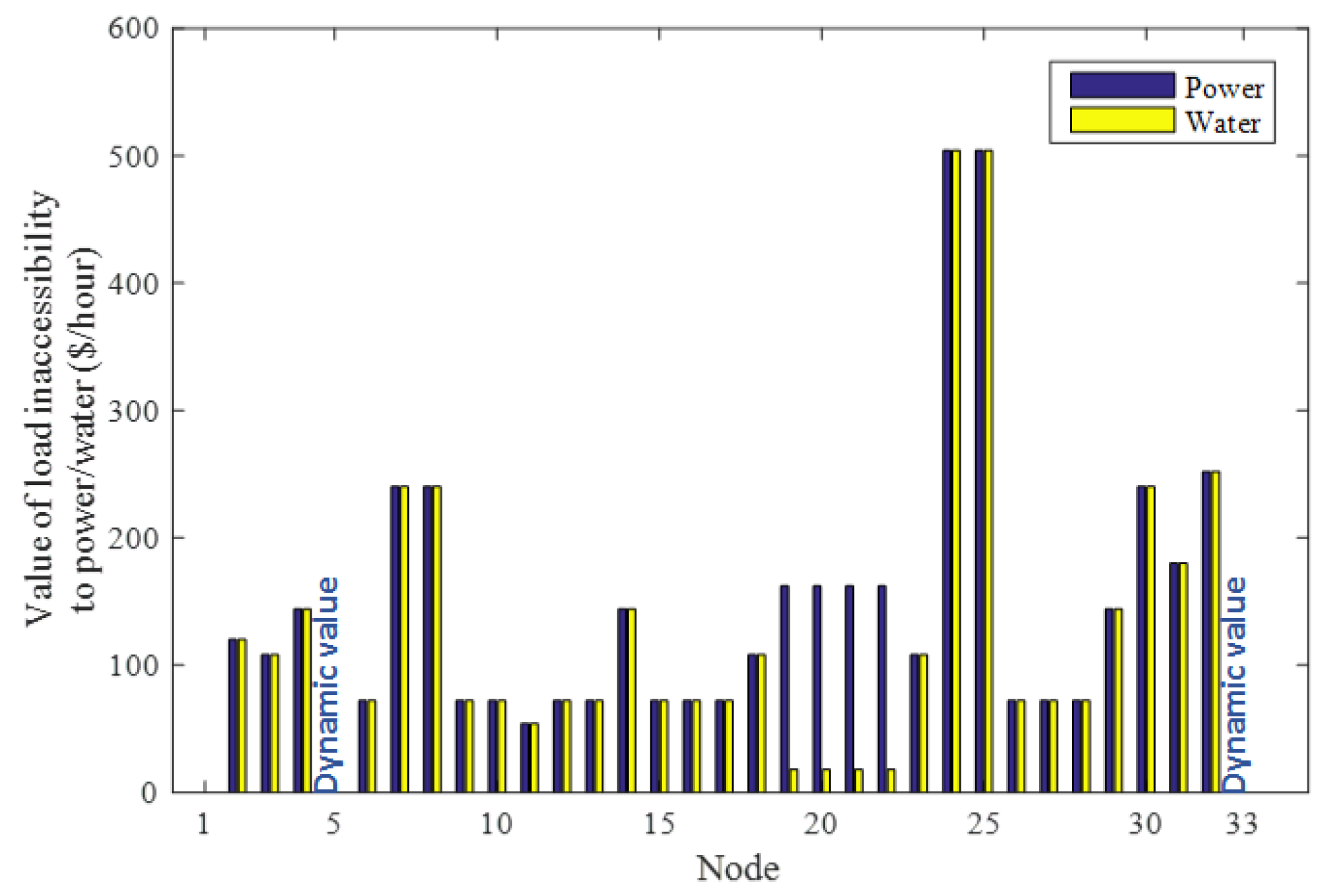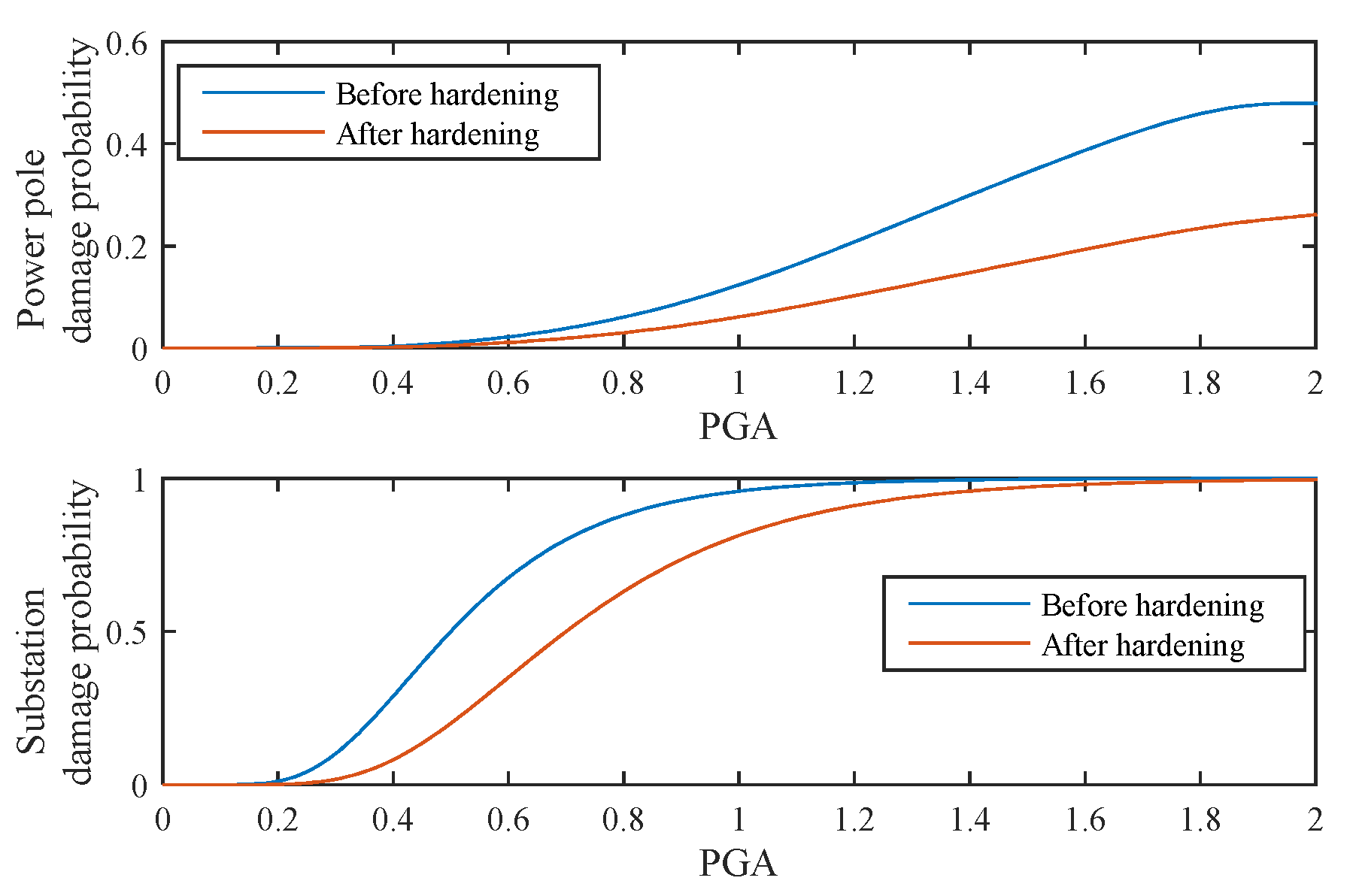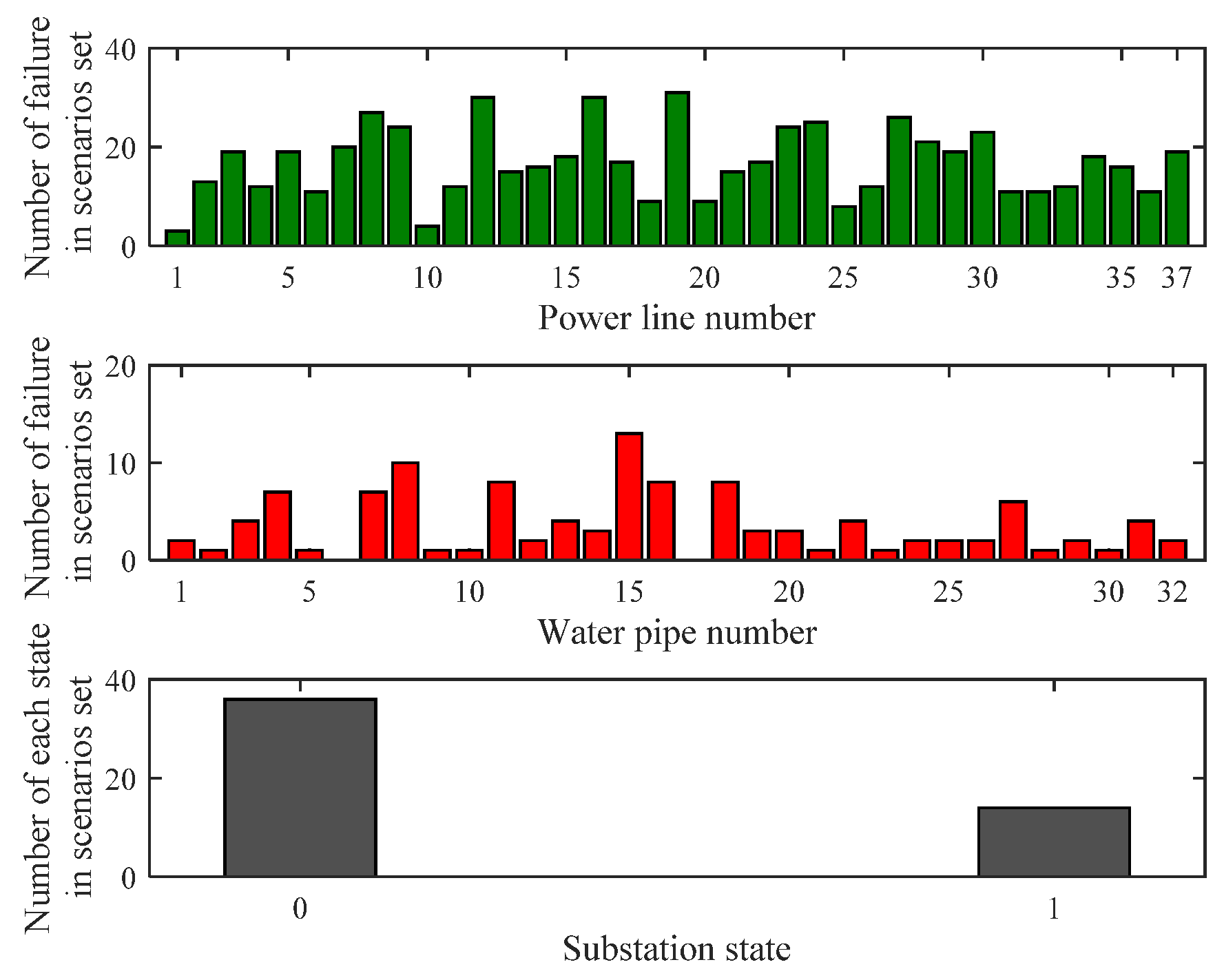Enhancing Integrated Power and Water Distribution Networks Seismic Resilience Leveraging Microgrids
Abstract
:1. Introduction
1.1. Background and Previous Works
1.1.1. Resilience Study of PDN
1.1.2. Resilience Study of WDN
1.1.3. Simultaneous Resilience Study of PDN and WDN
1.2. Contribution of The Paper
2. General Framework of the Proposed Stochastic Programming
3. Problem Formulation and Solution Methodology
3.1. Problem Formulation
3.2. Solution Methodology
4. Simulations and Results
- Case 1: In this case, the resilience improvement planning of PDN/WDN with DGs in PDN is solved for budget constraint equal to 100,000$. The results are shown in Table 2.
- Case 2: The goal of this case is to investigate the resilience of PDN and WDN without DGs. The results are expressed in Table 3. In this case, to compare the priority of chosen strategies with the previous case, the budget constraint is ignored and the problem is solved for obtaining four strategies.
- Case 3: In this case, it is assumed that all the water pumps are equipped to backup DGs during the whole emergency period. So, the only reason for loads inaccessibility to water is the water pipes damages. The results are tabulated in Table 4.
- Case 4: This case is designed to investigate the impact of the value of loads inaccessibility to power and water on the planning results. The only difference of this case and Case 1 is that the loads inaccessibility values for residential loads are considered fifty times bigger than Case 1 (Figure 4). In other words, the residential loads accessibility to water is very important than to the power in this system. According to Table 5, which shows the results of this case, all the chosen strategies are in such a way to improve the accessibility of loads to water. Therefore, chosen strategies in steps 1 and 4 make the path between the substation and the water pump in node 5 more robust and decrease the dependency of WDN on PDN. Other chosen strategies in steps 2 and 4 with the rehabilitation of the water pipes, decrease the vulnerability of WDN against earthquakes.
5. Conclusions
- Substation hardening as the most expensive but efficient strategy can enhance the resilience of PDN and WDN, significantly. When there is no DG in PDN and substation is the only power source, this strategy is chosen with high priority to improve resilience. This strategy can also decrease the dependency of WDN on PDN.
- Rehabilitation of some water pipes can significantly improve the accessibility of loads to water. It should be noted that the identification of such water pipes for rehabilitation cannot be done based on a simple approach such as the topological method. Therefore, it is vital to assess the WDN based on a physics-based equation in WDN.
- DGs are vital energy sources in PDN that can decrease the expected loads inaccessibility value to power and water by forming local microgrids. When there is no DG in PDN, strategies which enhance the path between substation and PDN will be chosen with high priority. Furthermore, in order to decrease the dependency of WDN to PDN with DGs, some strategies can be chosen to make a more robust path between DGs and important water pumps.
- The main reason for loads inaccessibility to water is the dependency of water pumps on power outages. This challenge should be considered in the resilience improvement problem.
- The importance of loads accessibility to power or water in a system affects the chosen strategies of the problem.
Author Contributions
Funding
Acknowledgments
Conflicts of Interest
Nomenclature
| Indices | |
| g, | Index and the number of DGs in microgrid u in scenario s at hour t |
| i, j | Bus indices |
| l, | Index and number of loads |
| ls, LS | Index and number of loops in WDN |
| n, | Index and number of nodes in WDN |
| pl, | Index and number of power lines |
| s, | Index and number of scenarios |
| t | Time index |
| sb, | Index and number of substations |
| u | Index for power network including the main network and intentionally islanded networks |
| wp, | Index and number of water pipes |
| Parameters and variables | |
| Cost of power line pl hardening, cost of water pipe wp rehabilitation and cost of substation sb hardening, respectively. | |
| Correction factors for the pipe diameter, pipe material, topography and liquefaction, respectively. | |
| Poisson cumulative distribution of earthquake magnitude | |
| Node n demand at time t | |
| Pipe wp flow rate at hour t in scenario s | |
| , | Conductance and susceptance of the line which connects bus i and j, |
| Hydraulic head loss of pipe wp in loop ls at hour t in scenario s | |
| , | Inaccessibility value of load l to power and water at hour t, respectively. |
| L | length of the pipe |
| Set of all links (pipes) connected to node n in WDN | |
| Specific magnitude magnitudes of the earthquake. | |
| , | Mean and standard deviation of cumulative normal distribution function |
| Number of power lines in network u in scenario s at hour | |
| Number of buses in network u in scenario s at hour t | |
| Number of fixed-head nodes in WDN | |
| , | First and the second objective function, respectively. |
| Fragility function of a water pipe, power pole and substation, respectively. | |
| , | Maximum active/reactive capacity of DG g |
| , | Active/reactive power of DG g in network u in scenario s at hour |
| , | Active/reactive loss of distribution line l in microgrid u in scenario s at hour t |
| , | Active and reactive power injected into bus i in network u in scenario s at hour t |
| , | Water pressure head and required water pressure head for full accessibility of a load to water, respectively. |
| The initial hour in each scenario (when the recovery of the networks starts right after the earthquake), the final hour in each scenario (when all the loads will access to power and water) | |
| Number of microgrids at hour t in scenario s | |
| Distance from the earthquake focus | |
| Probability of scenario s | |
| , | Accessibility state of load l to power and water at hour t in scenario s, respectively. |
| , | Binary variables that determine the power line pl is hardened or not, the water pipe wp is rehabilitated or not and the substation sb is hardened or not, respectively. |
| Difference phase voltage angle between bus i and j | |
| Voltage magnitude at bus i in network u in scenario s at hour t | |
| , | Minimum and maximum allowable voltage magnitude in the PDN |
| The line flow between bus i and j in network u in scenario s at hour t | |
| Maximum allowable line current capacity between bus i and j | |
References
- Najafi, J.; Peiravi, A.; Guerrero, J.M. Power distribution system improvement planning under hurricanes based on a new resilience index. Sustain. Cities Soc. 2018, 39, 592–604. [Google Scholar] [CrossRef]
- Anvari-Moghaddam, A.; Mohammadi-Ivatloo, B.; Asadi, S.; Guldstrand Larsen, K.; Shahidehpour, M. Sustainable Energy Systems Planning, Integration, and Management. Appl. Sci. 2019, 9, 4451. [Google Scholar] [CrossRef] [Green Version]
- Wang, Y.; Chen, C.; Wang, J.; Baldick, R. Research on resilience of power systems under natural disasters—A review. IEEE Trans. Power Syst 2016, 31, 1604–1613. [Google Scholar] [CrossRef]
- Kavousi-Fard, A.; Wang, M.; Su, W. Stochastic Resilient Post-Hurricane Power System Recovery Based on Mobile Emergency Resources and Reconfigurable Networked Microgrids. IEEE Access 2018, 6, 72311–72326. [Google Scholar] [CrossRef]
- Lei, S.; Wang, J.; Chen, C.; Hou, Y. Mobile emergency generator pre-positioning and real-time allocation for resilient response to natural disasters. IEEE Trans. Smart Grid 2018, 9, 2030–2041. [Google Scholar] [CrossRef] [Green Version]
- Zhu, J.; Yuan, Y.; Wang, W. An exact microgrid formation model for load restoration in resilient distribution system. Int. J. Elec. Power Energy Syst. 2020, 116, 105568. [Google Scholar] [CrossRef]
- Najafi, J.; Peiravi, A.; Anvari-Moghaddam, A.; Guerrero, J.M. An efficient interactive framework for improving resilience of power-water distribution systems with multiple privately-owned microgrids. Int. J. Elec. Power Energy Syst. 2020, 116, 105550. [Google Scholar] [CrossRef]
- Chowdhury, D.; Hasan, A.S.M.K.; Khan, M.Z.R. Scalable DC microgrid architecture with phase shifted full bridge converter based power management unit. In Proceedings of the 2018 10th International Conference on Electrical and Computer Engineering (ICECE), Dhaka, Bangladesh, 20–22 December 2018; pp. 22–25. [Google Scholar]
- Hasan, A.S.M.K.; Chowdhury, D.; Khan, M.Z.R. Scalable DC microgrid architecture with a one-way communication based control Interface. In Proceedings of the 2018 10th International Conference on Electrical and Computer Engineering (ICECE), Dhaka, Bangladesh, 20–22 December 2018; pp. 265–268. [Google Scholar]
- Lin, Y.; Bie, Z. Tri-level optimal hardening plan for a resilient distribution system considering reconfiguration and DG islanding. Appl. Energy 2018, 210, 1266–1279. [Google Scholar] [CrossRef]
- Ma, S.; Li, S.; Wang, Z.; Qiu, F. Resilience-oriented design of distribution systems. IEEE Trans. Power Syst. 2019, 34, 2880–2891. [Google Scholar] [CrossRef]
- Salman, A.M.; Li, Y. A probabilistic framework for multi-hazard risk mitigation for electric power transmission systems subjected to seismic and hurricane hazards. Struct. Infrastruct. Eng. 2018, 14, 1499–1519. [Google Scholar] [CrossRef]
- Dong, J.; Zhu, L.; Su, Y.; Ma, Y.; Liu, Y.; Wang, F.; Tolbert, L.M.; Glass, J.; Bruce, L. Battery and backup generator sizing for a resilient microgrid under stochastic extreme events. IET Gener. Transm. Distrib. 2018, 12, 4443–4450. [Google Scholar] [CrossRef]
- Najafi, J.; Peiravi, A.; Anvari-Moghaddam, A.; Guerrero, J.M. Power-Heat Generation Sources Planning in Microgrids to Enhance Resilience against Islanding due to Natural Disasters. In Proceedings of the 2019 IEEE 28th International Symposium on Industrial Electronics (ISIE), Vancouver, BC, Canada, 12–14 June 2019; pp. 2446–2451. [Google Scholar]
- Xie, H.; Teng, X.; Xu, Y.; Wang, Y. Optimal energy storage sizing for networked microgrids considering reliability and resilience. IEEE Access 2019, 7, 86336–86348. [Google Scholar] [CrossRef]
- Najafi, J.; Peiravi, A.; Anvari-Moghaddam, A.; Guerrero, J.M. Resilience improvement planning of power-water distribution systems with multiple microgrids against hurricanes using clean strategies. J. Clean. Prod. 2019, 223, 109–126. [Google Scholar] [CrossRef]
- Cimellaro, G.P.; Solari, D.; Bruneau, M. Physical infrastructure interdependency and regional resilience index after the 2011 Tohoku Earthquake in Japan. Earthq. Eng. Struct. D. 2014, 43, 1763–1784. [Google Scholar] [CrossRef]
- Kongar, I.; Esposito, S.; Giovinazzi, S. Post-earthquake assessment and management for infrastructure systems: learning from the Canterbury (New Zealand) and L’Aquila (Italy) earthquakes. B. Earthq. Eng. 2017, 15, 589–620. [Google Scholar] [CrossRef]
- Pudasaini, B.; Shahandashti, S.M. Identification of Critical Pipes for Proactive Resource-Constrained Seismic Rehabilitation of Water Pipe Networks. J. Infrastruct. Syst. 2018, 24, 04018024. [Google Scholar] [CrossRef]
- Salehi, S.; Jalili Ghazizadeh, M.; Tabesh, M. A comprehensive criteria-based multi-attribute decision-making model for rehabilitation of water distribution systems. Struct. Infrastruct. Eng. 2018, 14, 743–765. [Google Scholar] [CrossRef]
- Yoo, D.G.; Jung, D.; Kang, D.; Kim, J.H.; Lansey, K. Seismic hazard assessment model for urban water supply networks. J. Water Resour. Plan. Manag. 2016, 142, 04015055. [Google Scholar] [CrossRef]
- Yoo, D.G.; Jung, D.; Kang, D.; Kim, J.H. Seismic-reliability-based optimal layout of a water distribution network. Water 2016, 8, 50. [Google Scholar] [CrossRef] [Green Version]
- Farahmandfar, Z.; Piratla, K.; Andrus, R. Flow-based modeling for enhancing seismic resilience of water supply networks. Proceedings of Pipelines 2015, Baltimore, ML, USA, 23–26 August 2015; pp. 756–765. [Google Scholar]
- Farahmandfar, Z.; Piratla, K.R. Comparative Evaluation of Topological and Flow-Based Seismic Resilience Metrics for Rehabilitation of Water Pipeline Systems. J. Pipeline Syst. Eng. Pract. 2018, 9, 04017027. [Google Scholar] [CrossRef]
- Almoghathawi, Y.; Barker, K.; Albert, L.A. Resilience-driven restoration model for interdependent infrastructure networks. Reliab. Eng. Syst. Safe. 2019, 185, 12–23. [Google Scholar] [CrossRef]
- González, A.D.; Dueñas-Osorio, L.; Sánchez-Silva, M.; Medaglia, A.L. The interdependent network design problem for optimal infrastructure system restoration. Comput.-Aided Civ. Inf. Eng. 2016, 31, 334–350. [Google Scholar] [CrossRef]
- Zhang, Y.; Yang, N.; Lall, U. Modeling and simulation of the vulnerability of interdependent power-water infrastructure networks to cascading failures. J. Syst. Sci. Syst. Eng. 2016, 25, 102–118. [Google Scholar] [CrossRef]
- Nazemi, M.; Moeini-Aghtaie, M.; Fotuhi-Firuzabad, M.; Dehghanian, P. Energy storage planning for enhanced resilience of power distribution networks against earthquakes. IEEE Trans. Sustain. Energy 2019. [Google Scholar] [CrossRef]
- Panteli, M.; Pickering, C.; Wilkinson, S.; Dawson, R.; Mancarella, P. Power system resilience to extreme weather: Fragility modelling, probabilistic impact assessment, and adaptation measures. IEEE Trans. Power Syst. 2017, 32, 3747–3757. [Google Scholar] [CrossRef] [Green Version]
- Growe-Kuska, N.; Heitsch, H.; Romisch, W. Scenario reduction and scenario tree construction for power management problems. In Proceedings of the 2003 IEEE Bologna Power Tech Conference Proceedings, Bologna, Italy, 23–26 June 2003. [Google Scholar] [CrossRef]
- Zhang, H.; Cheng, X.; Huang, T.; Cong, H.; Xu, J. Hydraulic analysis of water distribution systems based on fixed point iteration method. Water Resour. Manag. 2017, 31, 1605–1618. [Google Scholar] [CrossRef]
- Yuan, C.; Illindala, M.S.; Khalsa, A.S. Modified Viterbi algorithm based distribution system restoration strategy for grid resiliency. IEEE Trans. Power Deliv. 2017, 32, 310–319. [Google Scholar] [CrossRef] [Green Version]
- Xu, Y.; Liu, C.-C.; Schneider, K.P.; Tuffner, F.K.; Ton, D.T. Microgrids for service restoration to critical load in a resilient distribution system. IEEE Trans. Smart Grid 2018, 9, 426–437. [Google Scholar] [CrossRef]
- Soto, R.; Crawford, B.; Misra, S.; Monfroy, E.; Palma, W.; Castro, C.; Paredes, F. Constraint programming for optimal design of architectures for water distribution tanks and reservoirs: a case study. Tehnički Vjesnik 2014, 21, 99–105. [Google Scholar]







| Component Repair Time (Hours) | ||||
|---|---|---|---|---|
| Power Line | Substation | Water Pipe | ||
| PGA | [0,0.5) | 4 | 6 | 6 |
| [0.5,1) | 6 | 8 | 8 | |
| [1,1.5) | 8 | 10 | 10 | |
| [1.5,2] | 10 | 12 | 12 | |
| Step | Strategy | EP(1) ($) | EW(2) ($) | EPW(3) ($) | Cost($) |
|---|---|---|---|---|---|
| 0 | No strategy | 19,872.4 | 15,091.4 | 34,963.8 | 0 |
| 1 | Power line 3–4 | 19,387.2 | 11,430.7 | 30,817.9 | 30,000 |
| 2 | Water pipe 6–7 | 19,387.2 | 10,922.5 | 30,309.7 | 4370 |
| 3 | Water pipe 4–5 | 19,387.2 | 10,416.5 | 29,803.7 | 8951 |
| 4 | Substation | 15,631.2 | 10,035.8 | 25,667 | 56,000 |
| Sum | 99,321 | ||||
| Step | Strategy | EP($) | EW($) | EPW($) | Cost($) |
|---|---|---|---|---|---|
| 0 | No strategy | 30,853.7 | 24,155.8 | 55,009.5 | 0 |
| 1 | Substation | 25,167.1 | 20,956.4 | 46,123.5 | 56,000 |
| 2 | Power line 1–2 | 24,820.6 | 20,232.4 | 44,753 | 10,000 |
| 3 | Power line 2–3 | 23,420.4 | 19,651.8 | 43,072.2 | 40,000 |
| 4 | Power line 3–4 | 22,971.1 | 17,707.4 | 40,678.5 | 30,000 |
| Sum | 136,000 | ||||
| Step | Strategy | EP($) | EW($) | EPW($) | Cost($) |
|---|---|---|---|---|---|
| 0 | No strategy | 19,647.4 | 4876.5 | 24,523.9 | 0 |
| 1 | Substation | 16,618.8 | 4876.5 | 21,495.3 | 56,000 |
| 2 | Water pipe 6–7 | 16,618.8 | 4693.5 | 21,312.3 | 4370 |
| 3 | Water pipe 4–5 | 16,618.8 | 3777.7 | 20,386.5 | 8951 |
| 4 | Power line 1–2 | 16,304.2 | 3777.7 | 20,081.9 | 10,000 |
| Sum | 79,321 | ||||
| Step | Strategy | EP($) | EW($) | EPW($) | Cost($) |
|---|---|---|---|---|---|
| 0 | No strategy | 19,872.5 | 739,190.4 | 759,062.9 | 0 |
| 1 | Power line 3–4 | 19,387.2 | 573,021.1 | 592,408.3 | 30,000 |
| 2 | Water pipe 6–7 | 19,387.2 | 535,115.2 | 554,502.4 | 4370 |
| 3 | Power line 4–5 | 19,064.4 | 450,448.5 | 469,512.9 | 30,000 |
| 4 | Water pipe 4–5 | 19,064.4 | 427,540.3 | 446,604.7 | 8951 |
| Sum | 73,321 | ||||
© 2020 by the authors. Licensee MDPI, Basel, Switzerland. This article is an open access article distributed under the terms and conditions of the Creative Commons Attribution (CC BY) license (http://creativecommons.org/licenses/by/4.0/).
Share and Cite
Najafi, J.; Peiravi, A.; Anvari-Moghaddam, A. Enhancing Integrated Power and Water Distribution Networks Seismic Resilience Leveraging Microgrids. Sustainability 2020, 12, 2167. https://doi.org/10.3390/su12062167
Najafi J, Peiravi A, Anvari-Moghaddam A. Enhancing Integrated Power and Water Distribution Networks Seismic Resilience Leveraging Microgrids. Sustainability. 2020; 12(6):2167. https://doi.org/10.3390/su12062167
Chicago/Turabian StyleNajafi, Javad, Ali Peiravi, and Amjad Anvari-Moghaddam. 2020. "Enhancing Integrated Power and Water Distribution Networks Seismic Resilience Leveraging Microgrids" Sustainability 12, no. 6: 2167. https://doi.org/10.3390/su12062167
APA StyleNajafi, J., Peiravi, A., & Anvari-Moghaddam, A. (2020). Enhancing Integrated Power and Water Distribution Networks Seismic Resilience Leveraging Microgrids. Sustainability, 12(6), 2167. https://doi.org/10.3390/su12062167






